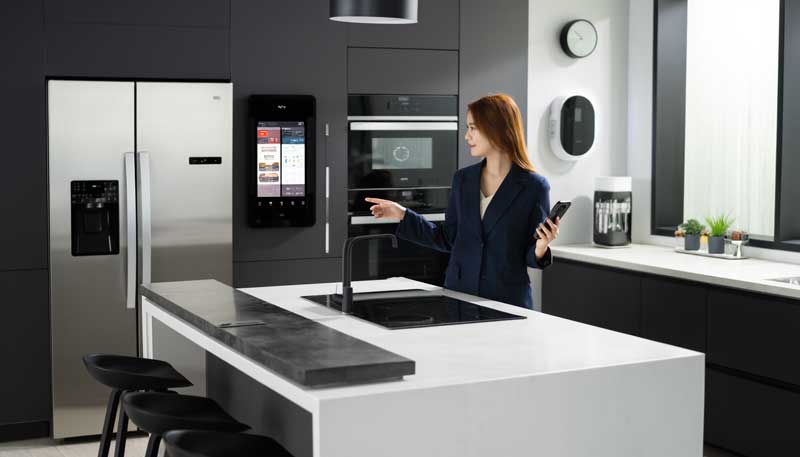Kitchen ➢ Kitchen Safety Guide
The Complete Guide to Kitchen Safety with Smart Technology

Kitchen safety has evolved dramatically with smart technology, transforming from reactive measures to proactive prevention systems. Modern smart kitchen devices can predict and prevent accidents before they occur, monitor food safety in real-time, and provide immediate alerts when dangerous conditions develop.
The integration of sensors, AI monitoring, and connected devices creates multiple layers of protection that work together to prevent the most common kitchen hazards: burns, cuts, fires, food poisoning, and gas leaks. These systems provide peace of mind while allowing you to focus on the joy of cooking.
Smart Fire Prevention and Detection
Advanced smoke and heat detectors designed specifically for kitchens can distinguish between cooking smoke and actual fire, reducing false alarms while providing faster response to real emergencies. These systems integrate with smart stove controls to automatically shut off heat sources when dangerous conditions are detected.
Smart range hoods with built-in sensors can detect excessive heat, smoke, or gas concentrations and automatically increase ventilation or trigger safety shutoffs. Some systems can even send smartphone alerts when you're away from home, allowing you to address potential issues remotely.
Induction cooktops with smart sensors automatically shut off when cookware is removed or when dangerous temperatures are reached, preventing overheating and reducing fire risk significantly compared to traditional gas or electric stoves.
Food Safety Monitoring and Temperature Control
Smart thermometers and temperature monitoring systems ensure food reaches safe cooking temperatures while preventing overcooking. These devices can monitor multiple temperature points simultaneously and provide alerts when food enters or leaves safe temperature zones.
Refrigerator and freezer monitoring systems track temperature fluctuations and alert you to potential food safety issues caused by power outages, door seals, or mechanical problems. Some systems can even suggest which foods to use first based on safety considerations.
Smart timers integrated with cooking appliances prevent food from being left unattended too long, reducing both food safety risks and the chance of burning or overcooking meals.
Burn and Injury Prevention
Motion sensors and proximity detectors can warn when hands get too close to hot surfaces or moving appliance parts. Some smart induction cooktops only activate when proper cookware is detected, preventing accidental contact with hot surfaces.
Smart pot and pan handles with temperature indicators show when cookware is too hot to touch safely. Advanced systems can even provide tactile feedback through smart kitchen gloves or wearable devices.
Automatic shut-off systems for small appliances ensure that devices don't continue operating when forgotten, preventing overheating and potential burns from unattended equipment.
Gas Leak Detection and Prevention
Smart gas detectors specifically designed for kitchen environments can identify even small gas leaks and automatically shut off gas supplies while alerting emergency contacts. These systems are far more sensitive than human detection and can identify dangerous concentrations before they become hazardous.
Smart gas range controls can detect when burners fail to ignite properly and automatically shut off gas flow, preventing accumulation of unburned gas. Some systems also monitor for proper combustion and alert users to ventilation issues.
Cut Prevention and Knife Safety
While technology can't eliminate the risk of cuts entirely, smart kitchen organization systems help maintain knife safety through proper storage alerts and maintenance reminders. Smart knife blocks can track when knives are removed and returned, helping ensure proper storage.
Cut-resistant gloves with smart sensors can provide feedback about grip and pressure, helping users develop safer cutting techniques. Some advanced systems can even detect when a cut has occurred and provide immediate first aid guidance.
Child Safety and Access Control
Smart locks and access controls can prevent children from accessing dangerous appliances or areas of the kitchen. These systems can be programmed with different access levels for different family members and can provide alerts when unauthorized access is attempted.
Induction cooktops with child safety features can detect the size and type of cookware, preventing activation by small objects while allowing normal cooking operations. Some systems require specific gestures or codes to activate, preventing accidental operation.
Emergency Response and Communication
Integrated emergency response systems can automatically contact emergency services when serious incidents are detected, while also alerting designated family members or neighbors. These systems can provide emergency responders with information about the type of incident and the layout of your kitchen.
Voice-activated emergency features allow hands-free calling for help when injuries occur, while smart home systems can unlock doors for emergency responders and provide them with access codes or instructions.
Creating a Comprehensive Safety System
The most effective kitchen safety approach combines multiple smart technologies that work together seamlessly. Start with the most critical safety concerns in your specific kitchen—whether that's fire prevention, food safety, or child protection—and build a system that addresses your highest-risk areas first.
Regular testing and maintenance of smart safety systems is crucial for continued effectiveness. Most smart kitchen safety devices include self-monitoring features that alert you to maintenance needs or system failures before they compromise safety.
Remember that smart technology enhances but doesn't replace basic kitchen safety practices. The most effective kitchen safety systems combine smart monitoring and prevention with good safety habits and proper training for all family members.
Share this article:
React to this article: